Physical Address
304 North Cardinal St.
Dorchester Center, MA 02124
It is important to take a patient-centered approach and implement shared decisionmaking when treating patients with Dupuytren disease because indications for intervention vary widely based on patients’ subjective functional limitations and needs.
Intervention for Dupuytren disease is most successful in instances when a cord develops and causes metacarpophalangeal (MCP) or proximal interphalangeal (PIP) joint contractures with functional consequences, including:
Difficulty grasping objects.
Difficulty performing fine motor tasks.
Catching of flexed finger (e.g., placing hand in pocket).
Inability to perform proper hygienic care of palmar tissue.
Objectively, intervention is indicated when the MCP joint has a greater than 30-degree contracture or the PIP joint has any degree of contracture.
Indications for the five main treatment options are as follows:
Enzymatic treatment with collagenase clostridium histolyticum (CCH) injection
This treatment is indicated when there is a distinct and easily palpable cord ( Fig. 98.1A ). This includes pretendinous, central, spiral, natatory, or adductor digiti minimi (ADM) cords leading to contractures of the MCP or PIP joint (see Fig. 98.1B ).
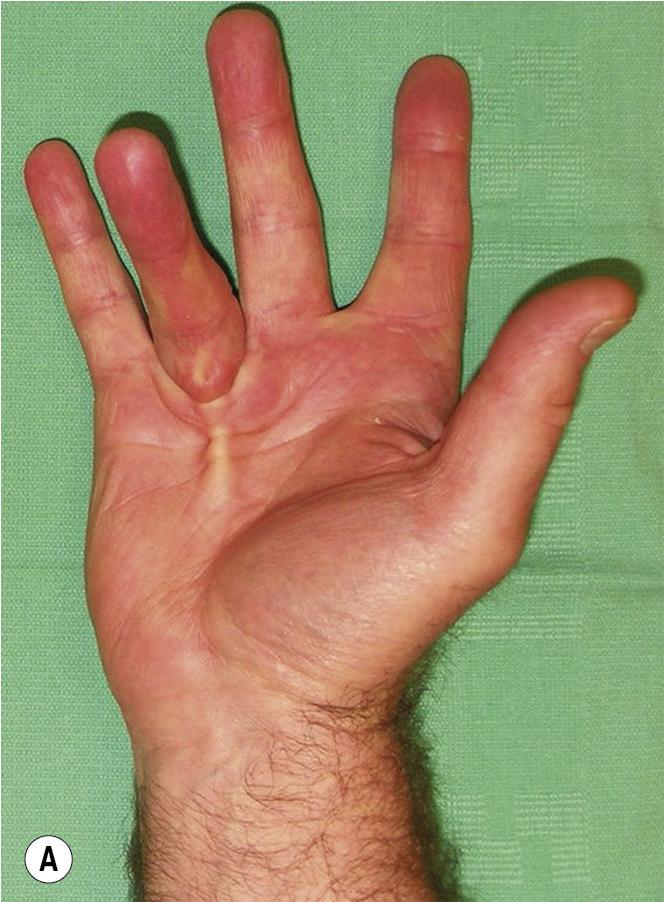
Up to two injections of CCH may be performed at once, either in two different cords in the same hand or at two sites along a single cord that hinders two separate joints.
Repeat CCH injections for recurrence are permissible.
Percutaneous needle aponeurotomy for Dupuytren contracture
This treatment is preferable for patients who seek a less invasive, less time-intensive, and less costly treatment and for frail patients who would not tolerate extensive surgical treatments.
Patients should have a distinct and easily palpable cord. This includes pretendinous or ADM cords causing MCP or PIP contracture.
We caution use of this procedure for recurrence after previous surgery because of the high risk for complications.
Partial open fasciectomy
This treatment is ideal for patients who desire a longer disease-free period (compared with CCH or needle aponeurotomy).
Patients typically have recurrent or recalcitrant contractures. They may also require concomitant joint capsulotomy or release of checkrein ligaments.
Partial open fasciectomy is also indicated if Dupuytren disease causes contractures in multiple digits ( Fig. 98.2 ) or if there is significant disease burden distal to the MCP joint crease; at this level, the neurovascular bundles are at greater risk for injury during CCH injection or needle aponeurotomy.

Dermatofasciectomy
This procedure is indicated to treat Dupuytren cords with extensive involvement of overlying skin, or recurrent Dupuytren cords that were previously excised.
Digit amputation
Digit amputation is reserved for end-stage disease with severely contracted digit (typically the small finger), immobile joints, and loss of soft tissue.
One contraindication is the absence of a functionally limiting contracture or soft-tissue complication (i.e., wound).
CCH is not indicated for isolate nodules or pits.
Another contraindication is the inability to comply with postprocedural splint protocol.
Contractures may recur rapidly without extension splinting in the early postinterventional period.
Visualize and palpate the hand to identify distinct cords that correlate with specific joint flexion deformities.
Identify nodules and explain to patients that the nodules will persist after CCH injection or needle aponeurotomy.
Identify confluence of cords interfering with function of multiple joints (e.g., natatory cords within the webspace adherent to pretendinous cords of adjacent digits).
Identify spiral cords because they displace neurovascular bundles superficially and centrally, placing the bundles at greater risk during interventions.
Evaluate joint flexion deformity:
For the tabletop test, have the patient place the palm of their hand on a table and identify cords that prevent contact with the table ( Fig. 98.3 ).
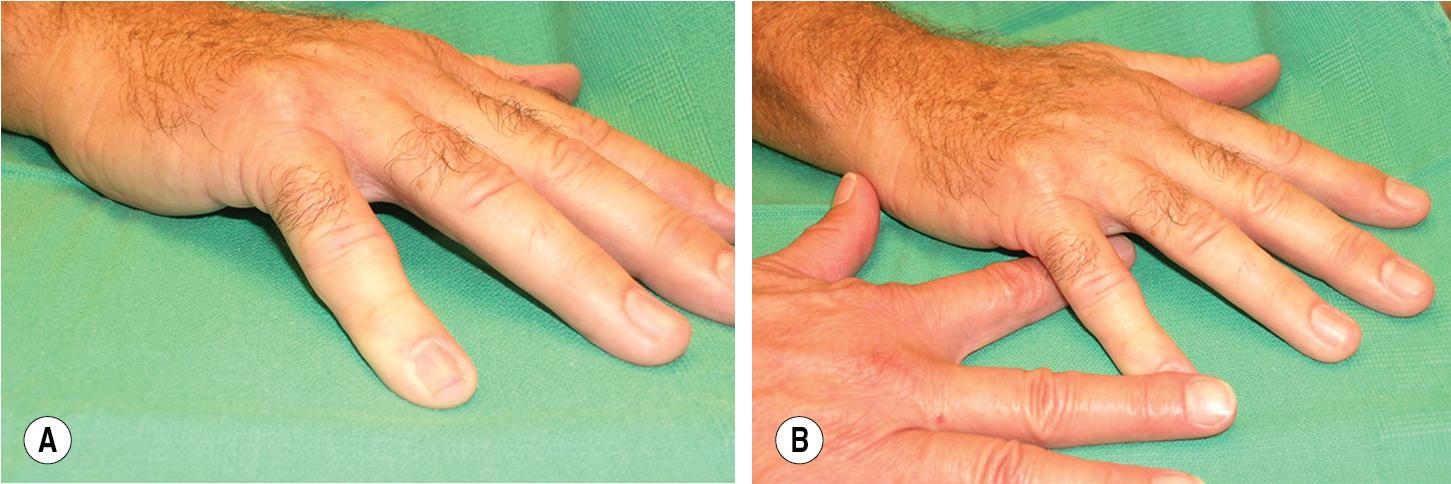
Use a goniometer to document joint flexion (helpful for monitoring progression of disease and outcomes after intervention).
Evaluate skin quality, depth of Dupuytren disease, and contracted tissue.
Thin, contracted skin adherent to the Dupuytren cord is at higher risk for wound complications after release.
Document baseline sensory examination of each finger.
Dupuytren disease affects the superficial palmodigital fascia ( Table 98.1 and Fig. 98.4A ):
Normal fascial or palmar aponeurotic (PA) elements consist of fibers in multiple directions that split into bands for each digit.
Normal elements are referred to as bands , and the correlating diseased elements are termed cords .
Cords are generally within 4 mm beneath the palmar skin.
| Cord | Location | Causes |
|---|---|---|
| Pretendinous (most frequent) | Palm | MCP flexion does not displace NV bundle |
| Vertical (uncommon—branches off pretendinous cord) | Palm | Painful triggering |
| Spiral (pretendinous/lateral/spiral bands and Grayson ligament) | Palm/digit | Displaces NV bundle to midline and palm |
| Natatory | Webspace/digit | Webspace contraction; limits finger abduction |
| Central extension of pretendinous cord | Digit | Usually does not displace NV bundle |
| Retrovascular | Digit | DIP contracture and prevents full correction of PIP contracture |
| Lateral (present with pretendinous and natatory cord and Grayson ligament) | Digit | DIP and PIP contracture; displaces NV bundle |
| Abductor digiti minimi (ADM) | ADM tendon | PIP contracture |
| Proximal/distal commissural | Proximal/distal commissural ligament | First webspace contracture |
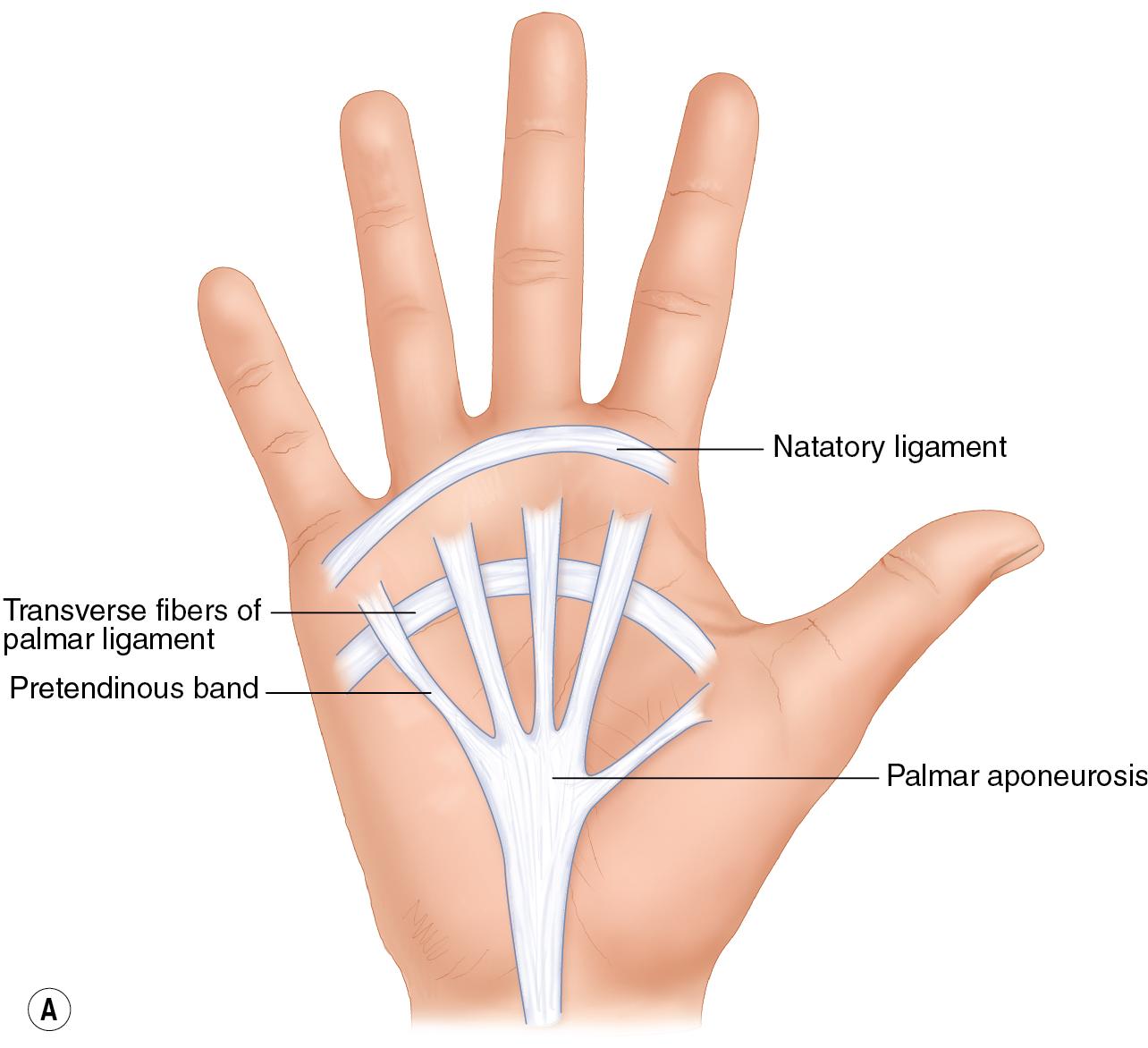
Bands
Longitudinal PA fibers are in three layers. The middle layer passes under the natatory ligament and neurovascular (NV) bundle, forming the spiral band. In the fingers, this becomes the lateral digital sheet (lateral to the NV bundle; see Fig. 98.4B ).
Transverse PA fibers contribute to the superficial transverse palmar ligament (not affected by Dupuytren disease) and to the natatory ligament that contributes to webspace shape and digital fascia.
In the fingers, the Grayson ligament is volar to the NV bundle, and the Cleland ligament is dorsal to the NV bundle (see Fig. 98.4C ).
Cords
Central cords are generally close in proximity to the palmar skin (and furthest from the flexor tendons) and most prominent between the distal palmar crease and palmodigital crease.
CCH injection and needle aponeurotomy are performed where the cord is identifiable.
MCP contracture: Proximal to palmodigital crease
PIP contracture: Distal to palmodigital crease
Spiral cords put the NV bundles at risk by pushing the NV bundles to the midline, whereas retrovascular cords can displace and/or compress the NV bundles by flexing the distal interphalangeal joint.
For CCH injection and needle aponeurotomy, surgeons should sit across from the patient while the affected extremity is laid supinated on a hand table.
Patients with procedural or needle phobia should be placed in a semirecumbent or recumbent supine position.
The surgeon can use the ulnar border of their nondominant hand to place gentle pressure to extend the affected finger, while still allowing their nondominant fingers to remain free to aid the dominant hand with cord localization and needle control.
CCH powder is reconstituted in a sterile diluent of 0.3 mg/mL calcium chloride dihydrate and 0.9% sodium chloride.
Each vial contains 0.9 mg of powdered CCH, but 0.58 mg is the recommended injection amount.
For MCP cord injections, use 0.39 mL of sterile diluent and plan to inject 0.25 mL of the solution.
For PIP cord injections, use 0.31 mL of sterile diluent and plan to inject 0.20 mL of the solution.
Once reconstituted, CCH can be kept at room temperature for 1 hour or refrigerated for up to 4 hours.
A short 27-gauge needle, ideally 0.5 in. long, should be used for injection.
Use a 1-mL tuberculin syringe with a nondetachable needle.
When extending the MCP or PIP (individually) of the affected digit, the cords that are drawn superficial and taut are likely responsible for tethering of the joint.
Palpate the target cord and mark the injection area (approximately a 5-mm area to permit three equally spaced aliquots).
MCP cords: Midpoint area between the distal palmar crease and the palmodigital crease.
PIP cords: Area just distal to the palmodigital crease (no more than 4 mm from the crease).
Inject 1 to 2 mL of local anesthetic subcutaneously at the target location but avoid overfilling and obscuring the palpable cord.
If a Y-shaped cord (e.g., the juncture of a central cord and natatory cord) is identified, consider injecting at the junction point of the Y—this may reach both cords from the one injection ( Fig. 98.5 ).
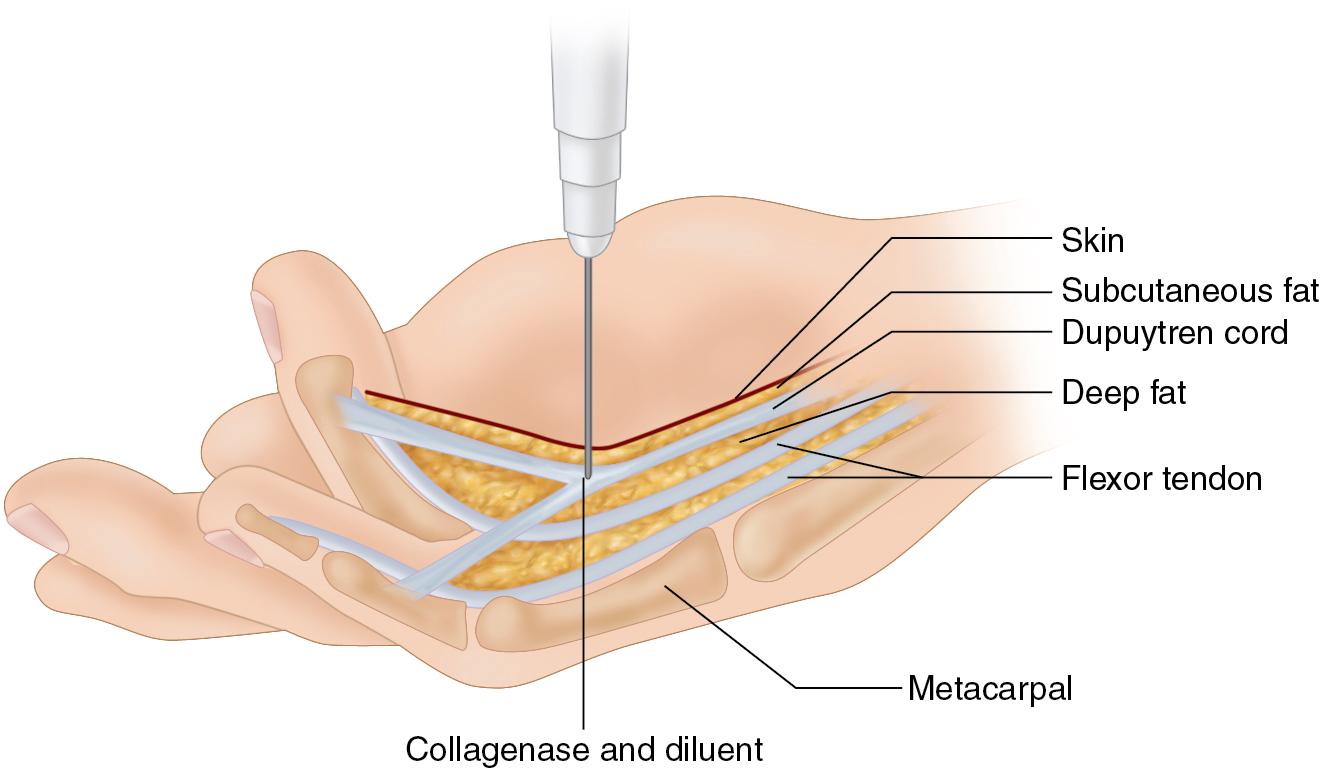
If possible, avoid injection in thin skin that is adherent to the underlying cord because these areas have a higher incidence of skin tears during manipulation.
Inject three small aliquots into target area of cord ( Fig. 98.6 ).
Cleanse the skin with alcohol.
Insert needle perpendicular to the skin, approximately 3 mm deep, and into the cord.
Inject one-third of the total injection volume. Expect to feel resistance to fluid flow because of the tight fibrous cord.
Remove needle and inject an additional one-third of volume 2 to 3 mm proximally and then distally from the initial injection into the same target cord.
Gently wrap the hand in a soft dressing. Patients may use the hand for regular tasks the same evening.
The surgeon can use their nondominant hand to identify the borders of the target cord and pinch the area to be injected to facilitate appropriate injection location ( Fig. 98.7 ).
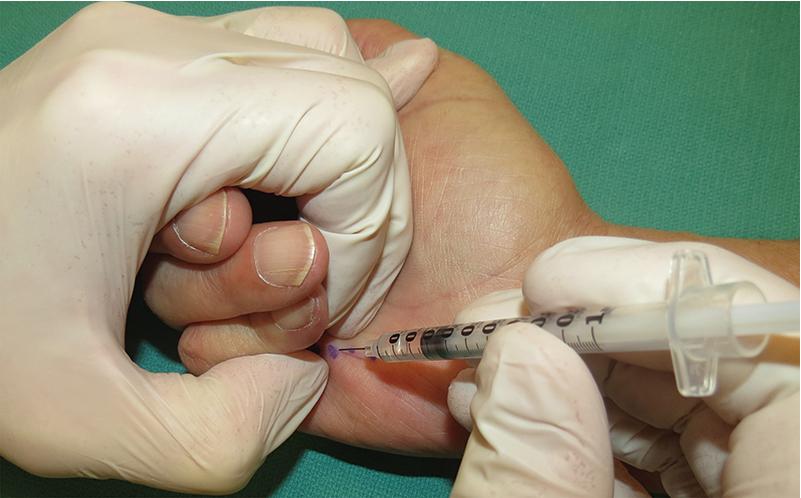
After inserting the needle, passively flex and extend the finger to confirm the needle is not in or abutting the flexor tendon.
The injection should be difficult and have resistance to CCH flow; if it flows too easily, stop injecting immediately because the needle has likely passed through the cord and is near the flexor tendon.
Patients should be counseled about potential side effects: edema, hyperemia, pain, ecchymosis, and even lymphangitis/axillary lymphadenopathy.
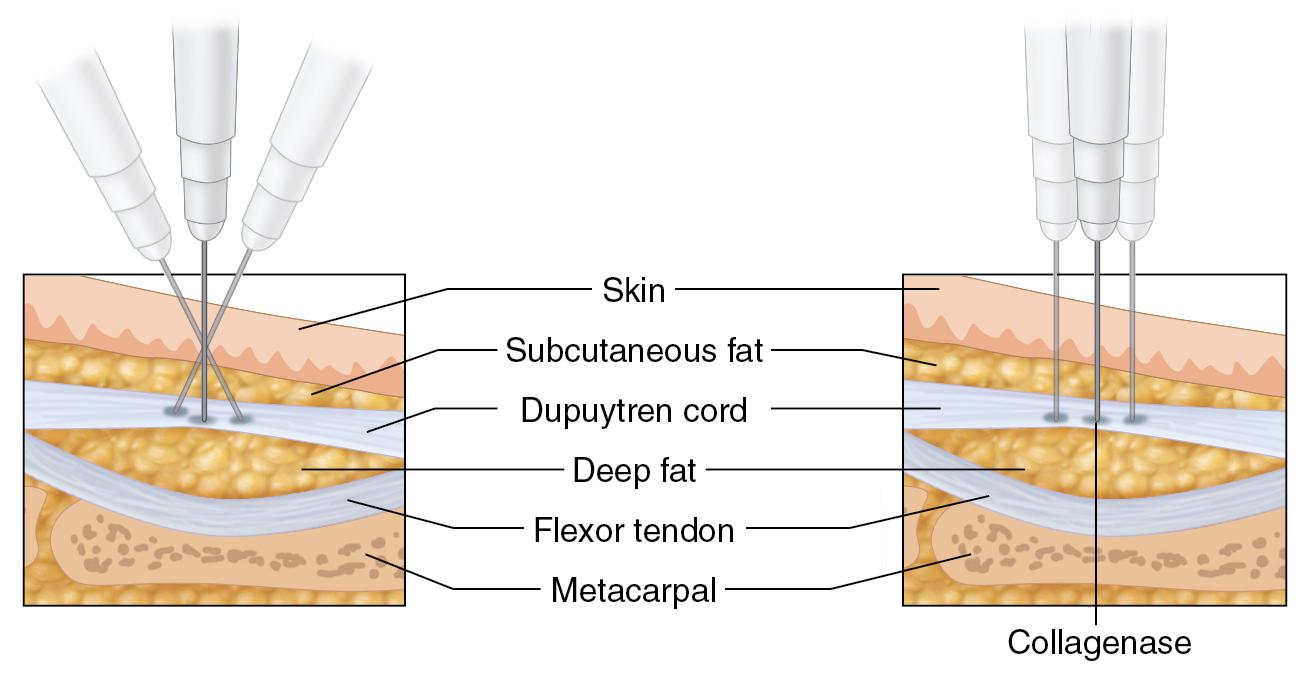
Evaluate the cord and determine whether there is already partial or complete cord rupture.
Relocalize the target cord and anesthetize the area (use local or intermetacarpal block).
Rupture the MCP cord by gently flexing the wrist and then use gentle, steady force to extend the finger with firm passive extension. Hold for 10 to 20 seconds.
Flex the PIP joint and push against the flexed finger to lever against the MCP cord ( Fig. 98.8 ).
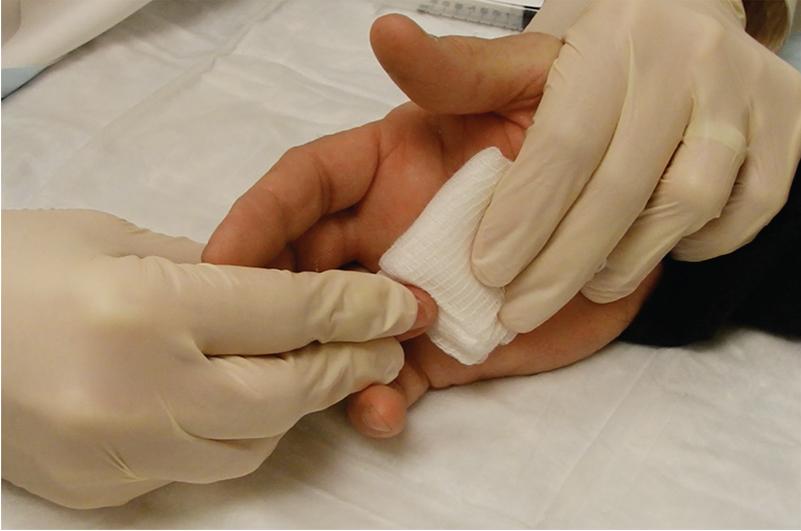
For PIP cords, flex at the MCP joint before forceful passive extension of the PIP joint.
After feeling the major “pop” of cord rupture, one can press along the cord with the fingertip and break up any additional residual fibrous bands.
If no rupture is achieved with the first attempt, one can attempt extension two additional times until the cord ruptures.
In fingers with substantial, long-standing PIP flexion deformity, underlying joint contracture may prevent full extension, even with successful cord rupture.
Furthermore, attenuation of the extensor mechanism may lead to persistent extensor lag in some cases.
Skin tears can occur with cord rupture. Even large tears heal with routine wound care in our experience ( Fig. 98.9A–B ).
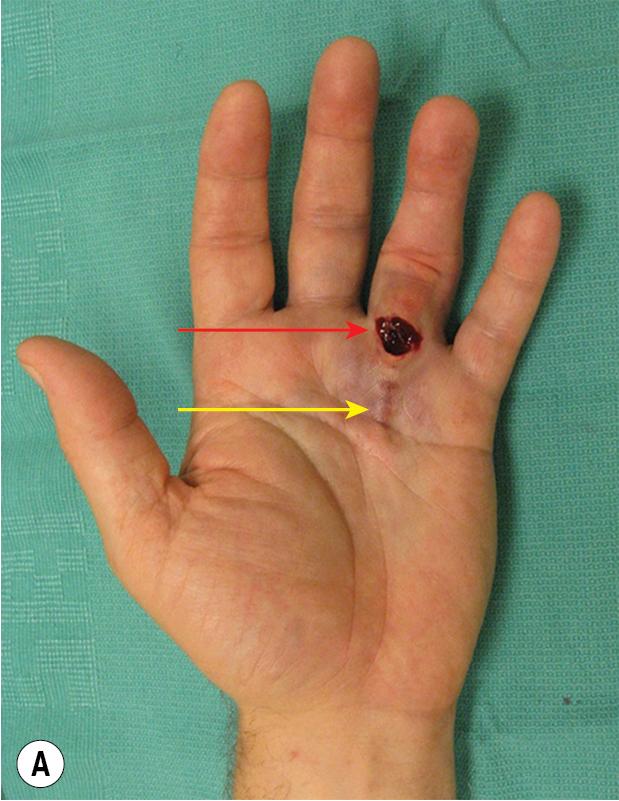
In patients with multiple cords, inject up to two cords in the same hand during a single treatment visit.
Injections and finger extension procedures may be administered up to three times per cord at approximately 4-week intervals.
Become a Clinical Tree membership for Full access and enjoy Unlimited articles
If you are a member. Log in here